Quan Sun
Step1X-Edit: A Practical Framework for General Image Editing
Apr 24, 2025Abstract:In recent years, image editing models have witnessed remarkable and rapid development. The recent unveiling of cutting-edge multimodal models such as GPT-4o and Gemini2 Flash has introduced highly promising image editing capabilities. These models demonstrate an impressive aptitude for fulfilling a vast majority of user-driven editing requirements, marking a significant advancement in the field of image manipulation. However, there is still a large gap between the open-source algorithm with these closed-source models. Thus, in this paper, we aim to release a state-of-the-art image editing model, called Step1X-Edit, which can provide comparable performance against the closed-source models like GPT-4o and Gemini2 Flash. More specifically, we adopt the Multimodal LLM to process the reference image and the user's editing instruction. A latent embedding has been extracted and integrated with a diffusion image decoder to obtain the target image. To train the model, we build a data generation pipeline to produce a high-quality dataset. For evaluation, we develop the GEdit-Bench, a novel benchmark rooted in real-world user instructions. Experimental results on GEdit-Bench demonstrate that Step1X-Edit outperforms existing open-source baselines by a substantial margin and approaches the performance of leading proprietary models, thereby making significant contributions to the field of image editing.
Taming Teacher Forcing for Masked Autoregressive Video Generation
Jan 21, 2025Abstract:We introduce MAGI, a hybrid video generation framework that combines masked modeling for intra-frame generation with causal modeling for next-frame generation. Our key innovation, Complete Teacher Forcing (CTF), conditions masked frames on complete observation frames rather than masked ones (namely Masked Teacher Forcing, MTF), enabling a smooth transition from token-level (patch-level) to frame-level autoregressive generation. CTF significantly outperforms MTF, achieving a +23% improvement in FVD scores on first-frame conditioned video prediction. To address issues like exposure bias, we employ targeted training strategies, setting a new benchmark in autoregressive video generation. Experiments show that MAGI can generate long, coherent video sequences exceeding 100 frames, even when trained on as few as 16 frames, highlighting its potential for scalable, high-quality video generation.
Emu3: Next-Token Prediction is All You Need
Sep 27, 2024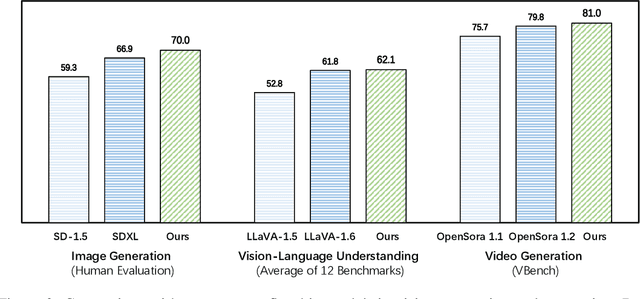

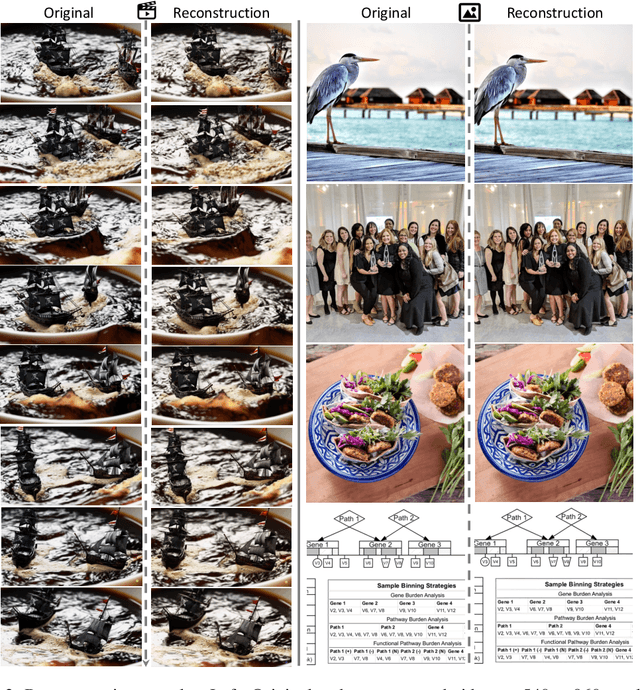
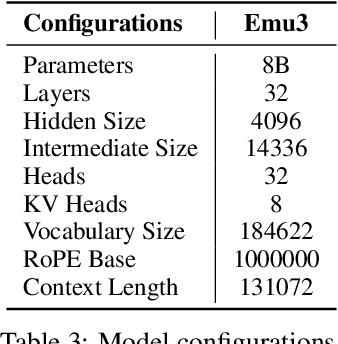
Abstract:While next-token prediction is considered a promising path towards artificial general intelligence, it has struggled to excel in multimodal tasks, which are still dominated by diffusion models (e.g., Stable Diffusion) and compositional approaches (e.g., CLIP combined with LLMs). In this paper, we introduce Emu3, a new suite of state-of-the-art multimodal models trained solely with next-token prediction. By tokenizing images, text, and videos into a discrete space, we train a single transformer from scratch on a mixture of multimodal sequences. Emu3 outperforms several well-established task-specific models in both generation and perception tasks, surpassing flagship models such as SDXL and LLaVA-1.6, while eliminating the need for diffusion or compositional architectures. Emu3 is also capable of generating high-fidelity video via predicting the next token in a video sequence. We simplify complex multimodal model designs by converging on a singular focus: tokens, unlocking great potential for scaling both during training and inference. Our results demonstrate that next-token prediction is a promising path towards building general multimodal intelligence beyond language. We open-source key techniques and models to support further research in this direction.
Diffusion Feedback Helps CLIP See Better
Jul 29, 2024Abstract:Contrastive Language-Image Pre-training (CLIP), which excels at abstracting open-world representations across domains and modalities, has become a foundation for a variety of vision and multimodal tasks. However, recent studies reveal that CLIP has severe visual shortcomings, such as which can hardly distinguish orientation, quantity, color, structure, etc. These visual shortcomings also limit the perception capabilities of multimodal large language models (MLLMs) built on CLIP. The main reason could be that the image-text pairs used to train CLIP are inherently biased, due to the lack of the distinctiveness of the text and the diversity of images. In this work, we present a simple post-training approach for CLIP models, which largely overcomes its visual shortcomings via a self-supervised diffusion process. We introduce DIVA, which uses the DIffusion model as a Visual Assistant for CLIP. Specifically, DIVA leverages generative feedback from text-to-image diffusion models to optimize CLIP representations, with only images (without corresponding text). We demonstrate that DIVA improves CLIP's performance on the challenging MMVP-VLM benchmark which assesses fine-grained visual abilities to a large extent (e.g., 3-7%), and enhances the performance of MLLMs and vision models on multimodal understanding and segmentation tasks. Extensive evaluation on 29 image classification and retrieval benchmarks confirms that our framework preserves CLIP's strong zero-shot capabilities. The code will be available at https://github.com/baaivision/DIVA.
EVA-CLIP-18B: Scaling CLIP to 18 Billion Parameters
Feb 06, 2024Abstract:Scaling up contrastive language-image pretraining (CLIP) is critical for empowering both vision and multimodal models. We present EVA-CLIP-18B, the largest and most powerful open-source CLIP model to date, with 18-billion parameters. With only 6-billion training samples seen, EVA-CLIP-18B achieves an exceptional 80.7% zero-shot top-1 accuracy averaged across 27 widely recognized image classification benchmarks, outperforming its forerunner EVA-CLIP (5-billion parameters) and other open-source CLIP models by a large margin. Remarkably, we observe a consistent performance improvement with the model size scaling of EVA-CLIP, despite maintaining a constant training dataset of 2-billion image-text pairs from LAION-2B and COYO-700M. This dataset is openly available and much smaller than the in-house datasets (e.g., DFN-5B, WebLI-10B) employed in other state-of-the-art CLIP models. EVA-CLIP-18B demonstrates the potential of EVA-style weak-to-strong visual model scaling. With our model weights made publicly available, we hope to facilitate future research in vision and multimodal foundation models.
Generative Multimodal Models are In-Context Learners
Dec 20, 2023Abstract:The human ability to easily solve multimodal tasks in context (i.e., with only a few demonstrations or simple instructions), is what current multimodal systems have largely struggled to imitate. In this work, we demonstrate that the task-agnostic in-context learning capabilities of large multimodal models can be significantly enhanced by effective scaling-up. We introduce Emu2, a generative multimodal model with 37 billion parameters, trained on large-scale multimodal sequences with a unified autoregressive objective. Emu2 exhibits strong multimodal in-context learning abilities, even emerging to solve tasks that require on-the-fly reasoning, such as visual prompting and object-grounded generation. The model sets a new record on multiple multimodal understanding tasks in few-shot settings. When instruction-tuned to follow specific instructions, Emu2 further achieves new state-of-the-art on challenging tasks such as question answering benchmarks for large multimodal models and open-ended subject-driven generation. These achievements demonstrate that Emu2 can serve as a base model and general-purpose interface for a wide range of multimodal tasks. Code and models are publicly available to facilitate future research.
CapsFusion: Rethinking Image-Text Data at Scale
Nov 02, 2023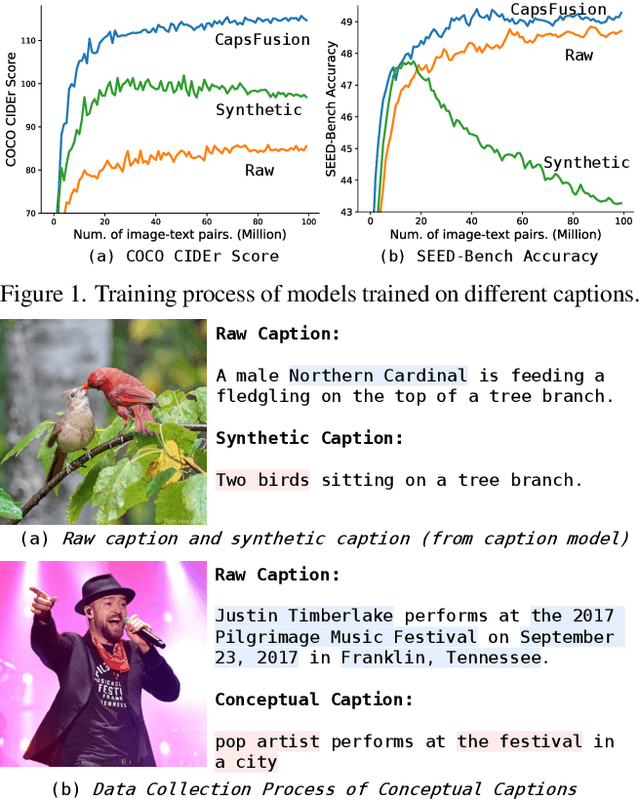
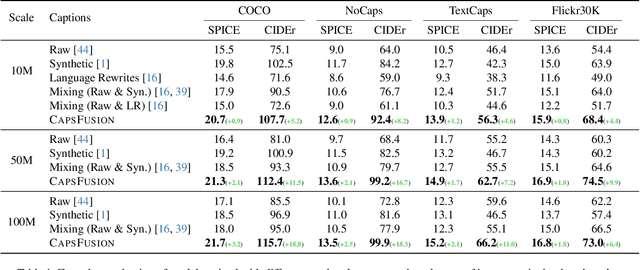

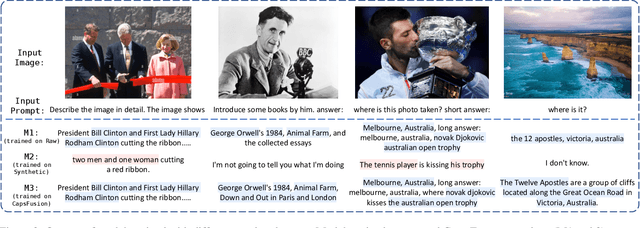
Abstract:Large multimodal models demonstrate remarkable generalist ability to perform diverse multimodal tasks in a zero-shot manner. Large-scale web-based image-text pairs contribute fundamentally to this success, but suffer from excessive noise. Recent studies use alternative captions synthesized by captioning models and have achieved notable benchmark performance. However, our experiments reveal significant Scalability Deficiency and World Knowledge Loss issues in models trained with synthetic captions, which have been largely obscured by their initial benchmark success. Upon closer examination, we identify the root cause as the overly-simplified language structure and lack of knowledge details in existing synthetic captions. To provide higher-quality and more scalable multimodal pretraining data, we propose CapsFusion, an advanced framework that leverages large language models to consolidate and refine information from both web-based image-text pairs and synthetic captions. Extensive experiments show that CapsFusion captions exhibit remarkable all-round superiority over existing captions in terms of model performance (e.g., 18.8 and 18.3 improvements in CIDEr score on COCO and NoCaps), sample efficiency (requiring 11-16 times less computation than baselines), world knowledge depth, and scalability. These effectiveness, efficiency and scalability advantages position CapsFusion as a promising candidate for future scaling of LMM training.
Generative Pretraining in Multimodality
Jul 11, 2023Abstract:We present Emu, a Transformer-based multimodal foundation model, which can seamlessly generate images and texts in multimodal context. This omnivore model can take in any single-modality or multimodal data input indiscriminately (e.g., interleaved image, text and video) through a one-model-for-all autoregressive training process. First, visual signals are encoded into embeddings, and together with text tokens form an interleaved input sequence. Emu is then end-to-end trained with a unified objective of classifying the next text token or regressing the next visual embedding in the multimodal sequence. This versatile multimodality empowers the exploration of diverse pretraining data sources at scale, such as videos with interleaved frames and text, webpages with interleaved images and text, as well as web-scale image-text pairs and video-text pairs. Emu can serve as a generalist multimodal interface for both image-to-text and text-to-image tasks, and supports in-context image and text generation. Across a broad range of zero-shot/few-shot tasks including image captioning, visual question answering, video question answering and text-to-image generation, Emu demonstrates superb performance compared to state-of-the-art large multimodal models. Extended capabilities such as multimodal assistants via instruction tuning are also demonstrated with impressive performance.
EVA-CLIP: Improved Training Techniques for CLIP at Scale
Mar 27, 2023



Abstract:Contrastive language-image pre-training, CLIP for short, has gained increasing attention for its potential in various scenarios. In this paper, we propose EVA-CLIP, a series of models that significantly improve the efficiency and effectiveness of CLIP training. Our approach incorporates new techniques for representation learning, optimization, and augmentation, enabling EVA-CLIP to achieve superior performance compared to previous CLIP models with the same number of parameters but significantly smaller training costs. Notably, our largest 5.0B-parameter EVA-02-CLIP-E/14+ with only 9 billion seen samples achieves 82.0 zero-shot top-1 accuracy on ImageNet-1K val. A smaller EVA-02-CLIP-L/14+ with only 430 million parameters and 6 billion seen samples achieves 80.4 zero-shot top-1 accuracy on ImageNet-1K val. To facilitate open access and open research, we release the complete suite of EVA-CLIP to the community at https://github.com/baaivision/EVA/tree/master/EVA-CLIP.
EVA-02: A Visual Representation for Neon Genesis
Mar 22, 2023Abstract:We launch EVA-02, a next-generation Transformer-based visual representation pre-trained to reconstruct strong and robust language-aligned vision features via masked image modeling. With an updated plain Transformer architecture as well as extensive pre-training from an open & accessible giant CLIP vision encoder, EVA-02 demonstrates superior performance compared to prior state-of-the-art approaches across various representative vision tasks, while utilizing significantly fewer parameters and compute budgets. Notably, using exclusively publicly accessible training data, EVA-02 with only 304M parameters achieves a phenomenal 90.0 fine-tuning top-1 accuracy on ImageNet-1K val set. Additionally, our EVA-02-CLIP can reach up to 80.4 zero-shot top-1 on ImageNet-1K, outperforming the previous largest & best open-sourced CLIP with only ~1/6 parameters and ~1/6 image-text training data. We offer four EVA-02 variants in various model sizes, ranging from 6M to 304M parameters, all with impressive performance. To facilitate open access and open research, we release the complete suite of EVA-02 to the community at https://github.com/baaivision/EVA/tree/master/EVA-02.
 Add to Chrome
Add to Chrome Add to Firefox
Add to Firefox Add to Edge
Add to Edge